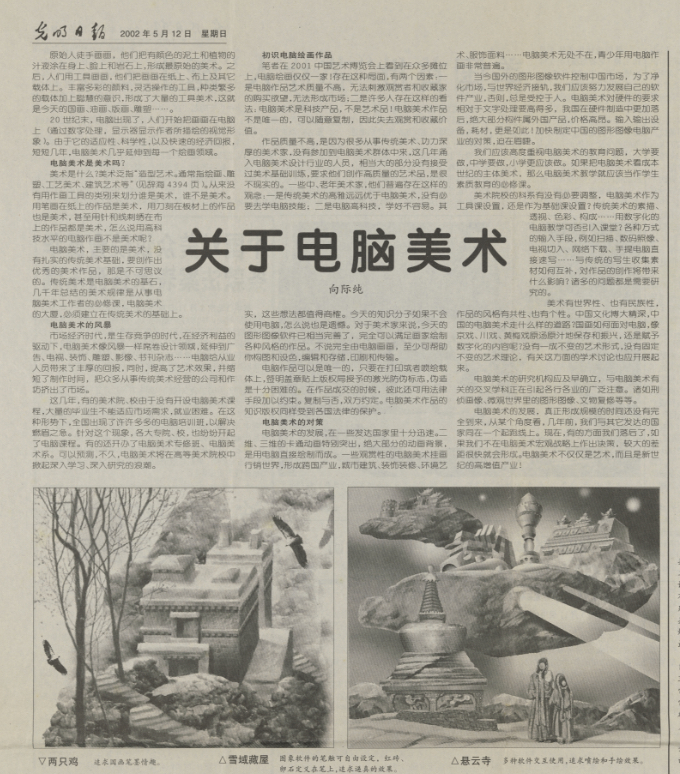
Primitive people drew pictures with their bare hands. They smeared colored mud and plant sap on their bodies, faces and rocks, creating the most primitive form of art. Later, people used tools to add to it. They painted on paper, cloth and other carriers. With a rich variety of pigments, skillful use of tools, and a wide range of carriers, along with intelligent consciousness, a large number of painting arts were formed. These are today's traditional Chinese painting, oil painting, printmaking, sculpture...
At the end of the 20th century, computers emerged and people began to paint on them (through digital processing, the visual images created by the author are displayed on the monitor). Due to its adaptability, scientific nature, and rapid economic returns, within just a few years, computer art has almost permeated every field of painting.
Is computer art art?
What is art? Art generally refers to "plastic arts. Usually it refers to painting, sculpture, applied art, architectural art, etc." (See page 4394 of Cihai). It has never been distinguished by the tools used for painting.
A work painted with a pen on paper is art, a work carved with a knife on a board is art, and even a work embroidered with a needle and thread on cloth is art. How can a work created with high-tech computers not be art?
Computer art is mainly art. Without a solid foundation in traditional art, it is inconceivable to create excellent art works. Traditional art is the cornerstone of computer art. The art laws summarized over thousands of years are compulsory courses for those engaged in computer art. The edifice of computer art must be built on a solid foundation of art.
The Storm of Computer Art
In the era of market economy, it is an era of survival competition. Driven by economic interests, computer art has swept through the design field like a storm, penetrating into advertising, television, decoration, sculpture, video, books and magazines... Computers have brought rich returns to practitioners, while enhancing artistic effects and shortening production time, pushing many companies and artists engaged in traditional art out of the market.
In recent years, some art academies and schools have not offered computer art courses, and a large number of graduates have been unable to adapt to market demands and have difficulty finding employment. In this situation, numerous computer training classes have emerged across the country to address the urgent need. In response to this phenomenon, colleges and universities have also opened computer courses. Some have even established computer art special courses and computer art departments. It can be predicted that soon, computer art will eventually trigger a craze for learning and in-depth research in higher art institutions.
First Encounter with Computer Paintings
At the 2001 China Art Expo, the author saw that among numerous booths, computer paintings occupied only a small space! There are two factors contributing to this situation: First, the artistic quality of computer works is not high, failing to stimulate the purchasing desire of viewers and collectors and thus unable to form a market. Second, many people hold the view that computer art is a technological product, not an art piece! Computer art works are not unique and can be replicated at will, thus losing their value for appreciation and collection.
The low quality of works is due to the fact that many traditional artists with profound skills have not participated in the computer art community. In recent years, a considerable number of people who have joined the computer art design industry have not systematically learned basic art training. It is extremely unrealistic to expect them to create high-quality artworks. Many middle-aged and elderly artists generally hold the following views: First, the artistic taste of traditional art is far superior to that of computer art, and there is no need to learn computer technology. Second, they think that computer technology is highly advanced and difficult to learn. In fact, these ideas are all questionable. For today's intellectuals, it is a pity if they do not know how to use computers. For artists, today's graphic and image software is quite complete and can fully meet the needs of creating works in various styles. Even if it is not completely computer-painted, it can at least help with composition and coloring, storage and editing, printing and transmission.
Computer works can be unique. As long as they are signed, stamped, and affixed with the laser anti-counterfeiting label granted by the copyright bureau on the printing or spray-painting medium, they can be very effective. When the work is sold, both parties can also use legal means to bind each other. Whether to copy or not can be agreed upon by both parties. The copyright of computer art works is also protected by the laws of various countries.
Countermeasures for Computer Art
The development of computer art is very rapid in some developed countries. Two-dimensional and three-dimensional cartoon animations are particularly prominent, and the vast majority of animation backgrounds are drawn by computer. Some decorative computer art paintings are sold all over the world, forming a transnational industry. Computer art is everywhere, from urban architecture, interior decoration, environmental art to clothing fabrics. It is very common for teenagers to create art with computers.
At present, foreign graphic and image software dominates the Chinese market. To purify the market and integrate with the world economy, we must strive to develop our own software industry. Otherwise, we will always be controlled by others. The requirements for hardware in computer art are much higher than those for word processing. China is even more backward in hardware manufacturing, and most components are foreign products with high prices. Input and output devices and consumables are especially so! It is urgent to formulate countermeasures for China's graphic and image computer industry.
We should attach great importance to the education of computer art. Universities should do it, middle schools should do it, and primary schools should do it even more. If we consider computer art as the main art form of the 21st century, then computer art teaching should be a compulsory course for students' quality education.
Should the departments of art colleges be adjusted? Should computer art be set as a tool course or a basic course? Can digital computer teaching of traditional art such as sketching, perspective, color, and composition be introduced into the classroom? How can various input methods, such as scanning, digital cameras, TV capture, network download, and direct sketching with laptops, complement traditional on-site sketching for collecting materials, and what impact will it have on the creation of works? These and many other issues need to be studied urgently.
Art has both universality and nationality. The style of works has both commonality and individuality. Chinese culture is profound and extensive. What path should Chinese computer art take? How should traditional Chinese painting face computers? How should woodcut prints, watercolors, and oil paintings be preserved and revitalized in their original form, or should they be given digital content? There is no unchanging art form and no fixed art theory. Academic discussions on this aspect should also be carried out.
Research institutions for computer art need to be established urgently. Interdisciplinary fields related to computer art are attracting widespread attention from all walks of life. For example, criminal investigation (criminal investigation portraits), graphics and images in the virtual world, and cultural relic restoration, etc.
The development of computer art has not yet truly reached a large scale. From a certain perspective, a few years ago, we were on the same starting line as other developed countries. Now, in some aspects, we have fallen behind. If we do not make decisions on the macro strategy of computer art, a huge gap will soon form. Computer art is not only art but also a high-growth industry in the new century!
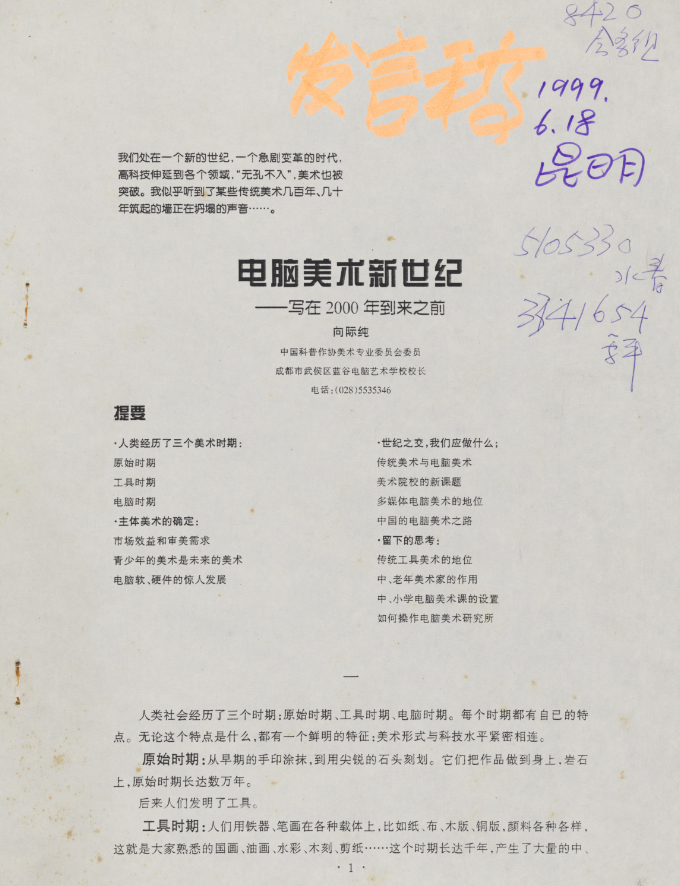
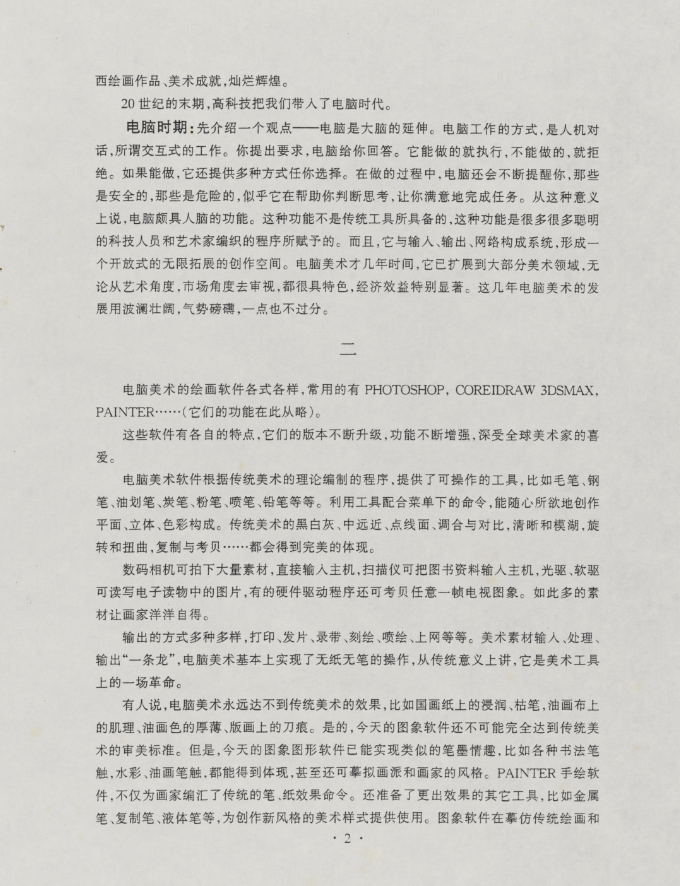
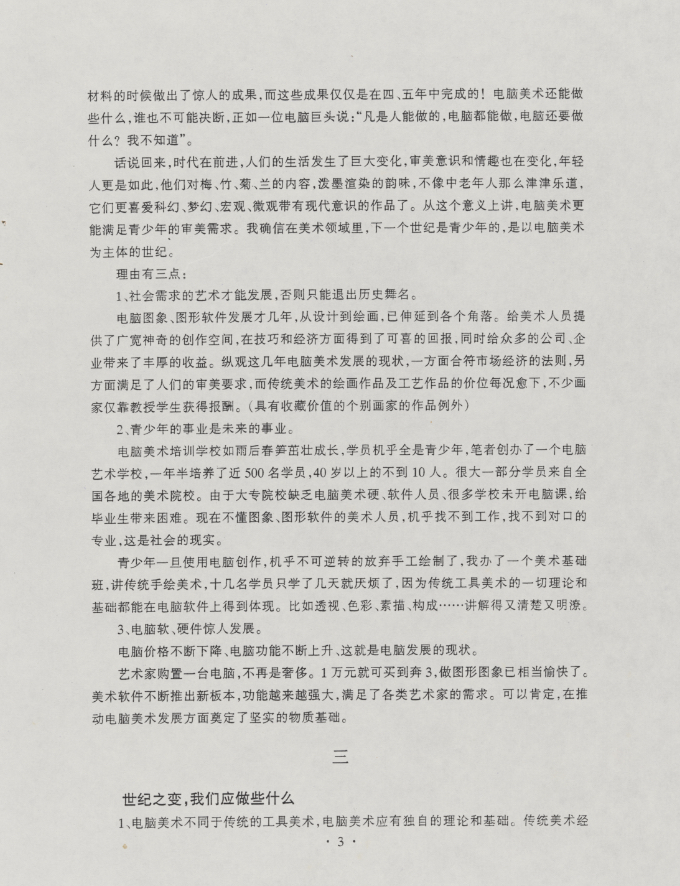
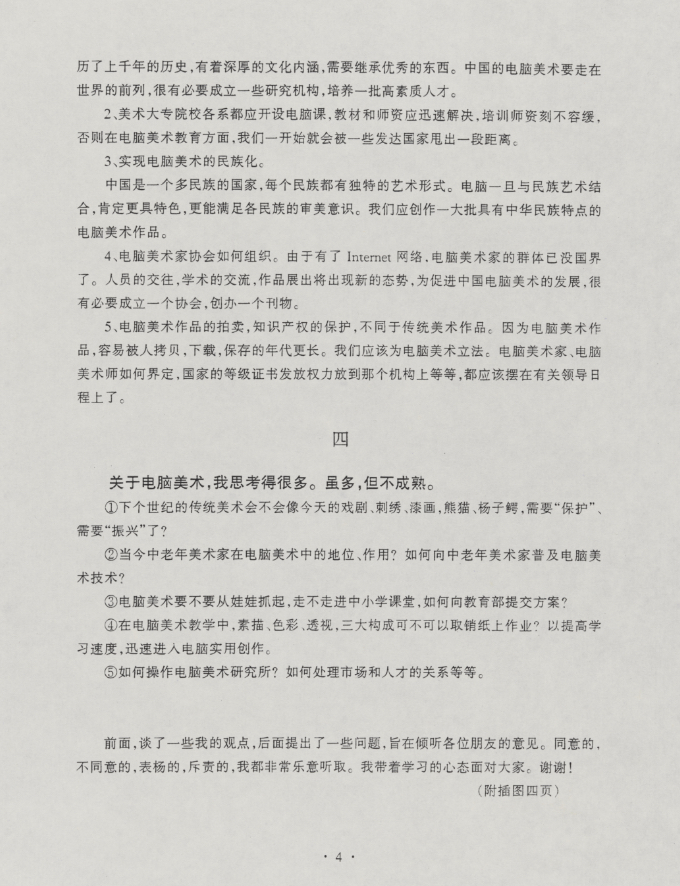
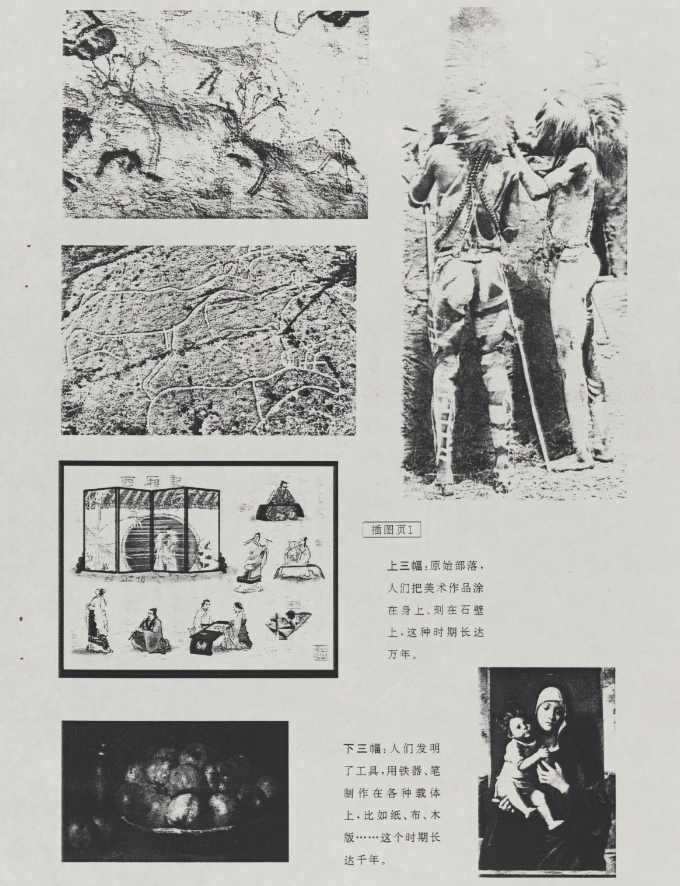
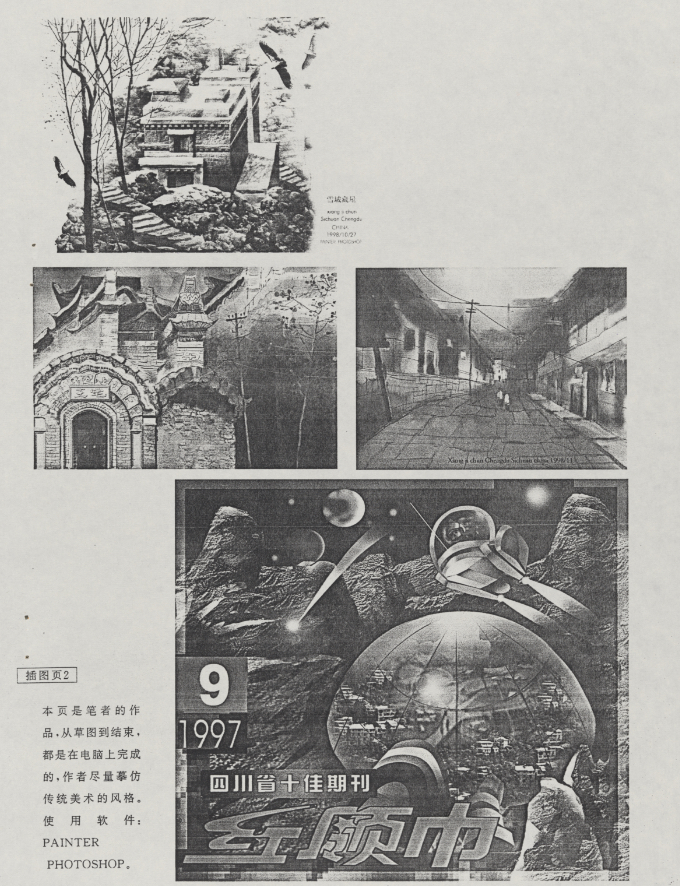
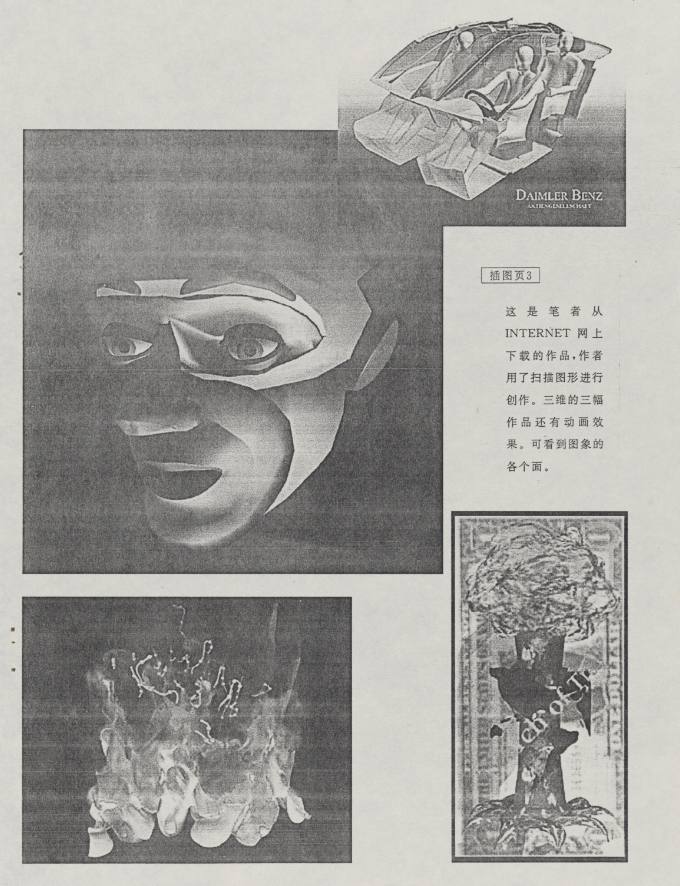
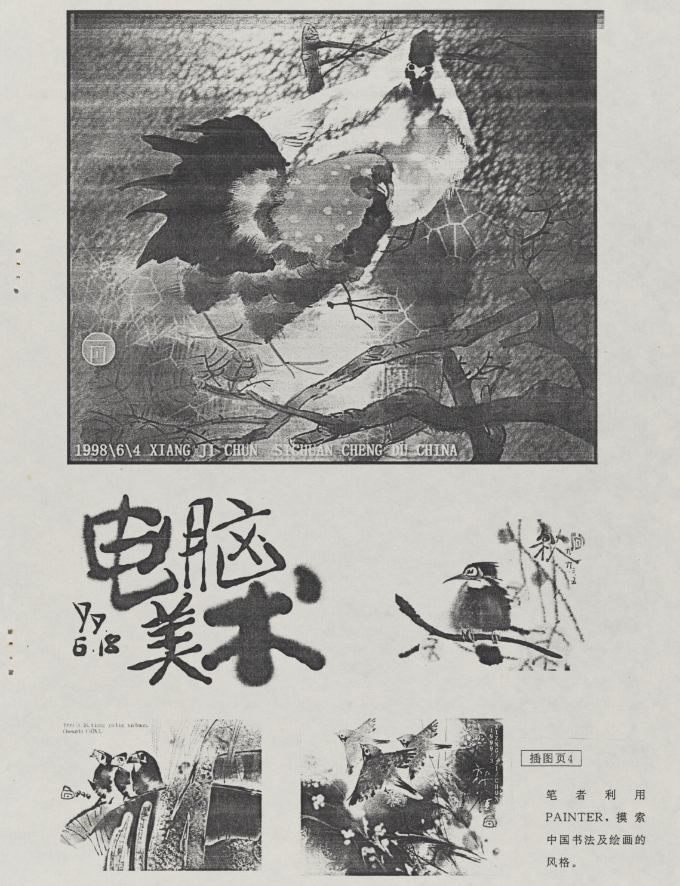
The New Era of Computer Art - Written Before the Arrival of 2000
Ji Chun Xiang
Member of the Art Committee of the China Science Popularization Association
Principal of Chengdu Wuhou District Blue Valley Computer Art School
We are in a new century, a time of rapid change. High technology has extended into every field and is omnipresent. Art has also been broken through. It seems that I have heard the sound of some traditional art walls that have been built for hundreds or even decades collapsing...
Summary
1. Humans have gone through three periods of art:
The primitive period
The tool-using period
The computer era
2. Determination of the main art form:
Market benefits and aesthetic demands
The art of teenagers is the art of the future
The astonishing development of computer software and hardware
3.At the turn of the century, what should we do:
Traditional art and computer art
New topics for art colleges
The status of multimedia computer art
The path of computer art in China
4. Thoughts left behind:
The status of traditional tool-based art
The role of middle-aged and elderly artists
The establishment of computer art courses in primary and secondary schools
How to operate the computer art research institute
Human society has gone through three periods: the primitive period, the tool-using period, and the computer era. Each period has its own characteristics. No matter what these characteristics are, there is one distinct feature: the forms of art are closely linked to the level of technology.
Primitive Era: From the early application of hand prints to the use of sharp stones for carving. They left their marks on the bodies and rocks. This process lasted for tens of thousands of years during the primitive era.
Later, people invented tools.
The Tool Era: People used iron tools and brushes to draw on various materials, such as paper, cloth, wood blocks, metal plates, and many others. This is what we commonly refer to as traditional Chinese painting, oil painting, watercolor painting, woodcut, paper-cutting, etc. This era lasted for thousands of years and produced a large number of Chinese and Western paintings and artistic achievements, which were splendid and magnificent.
In the late 20th century, high technology brought us into the computer age.
The Computer Era: Let's introduce a viewpoint - computers are the extension of the human brain. The way computers work is through human-computer interaction, which is known as interactive work. You make a request, and the computer gives you an answer. It does what it can and refuses what it can't. If it can do it, it also offers multiple options for you to choose from. During the process, the computer constantly reminds you which are safe and which are dangerous, as if it is helping you make judgments and think, allowing you to complete the task satisfactorily. In this sense, computers possess functions similar to those of the human brain. This function is not possessed by traditional tools. This function is bestowed by the programs woven by many, many intelligent technicians and artists. Moreover, it integrates input, output, and connection to form a system, creating an open and infinitely expanding creative space. Computer art has only been around for a few years, but it has expanded into most of the art fields. Whether from an artistic perspective or a market perspective, it is very distinctive and has particularly significant economic benefits. The development of computer art in these years has been magnificent and imposing, not at all excessive.
There are numerous painting software for computer art. Commonly used ones include PHOTOSHOP, COREIDRAW, 3DSMAX, PAINTER... These software have their own unique features. Their versions are constantly upgraded and their functions are continuously enhanced, and they are highly favored by artists all over the world.
The computer art software, based on the theories of traditional art, has developed a set of programming procedures, providing practical tools such as brushes, pens, oil brushes, pencils, chalks, spray pens, pencils, etc. By using these tools in combination with the commands under the menu, one can freely create flat, three-dimensional, and color compositions. The traditional art elements of black and white, tones, near and far distances, points, lines, and surfaces, blending and contrast, clarity and modulation, rotation and distortion, duplication and transformation, etc., can all be perfectly demonstrated.
Digital cameras can capture a large amount of material, which can be directly input into the host computer. Scanners can input book materials into the host computer. CD-ROMs and floppy disks can read and write pictures in electronic books. Some hardware drivers can even convert any TV image. With so much material, the painter feels extremely pleased.
The output methods are diverse, including printing, photocopying, video recording, engraving, inkjet printing, internet access, and more. The entire process of inputting, processing, and outputting artistic materials is "one-stop service". Computer art has basically achieved paperless and penless operation. From a traditional perspective, it represents a revolution in artistic tools.
Some people say that computer art can never achieve the effects of traditional art, such as the moistness and dry brush strokes on traditional Chinese painting paper, the texture and thickness of oil painting on canvas, and the knife marks on printmaking. Yes, today's image software is still unable to fully meet the aesthetic standards of traditional art. However, today's image graphic software can already achieve similar ink-wash charm, such as various calligraphy brushstrokes, watercolor and oil painting brushstrokes, which can all be reflected, and even the styles of art schools and painters can be simulated. The PAINTER painting software not only compiles traditional pen and paper effect commands for painters. It also prepares other more effective tools, such as metal pens, copy pens, liquid pens, etc., to provide usage for creating new styles of art. Image software has achieved astonishing results when imitating traditional painting and materials, and these results were accomplished in just four or five years! What else can computer art do? No one can decide. Just as a computer giant said: "Anything that humans can do, computers can do. What else does the computer need to do? I don't know."
Anyway, times are advancing and people's lives have undergone tremendous changes. Aesthetic consciousness and tastes have also changed. This is especially true for young people. They are not as enthusiastic about the content of plum blossoms, bamboos, chrysanthemums, and orchids, as well as the ink-wash rendering style, as middle-aged and elderly people are. Instead, they prefer works with modern consciousness such as science fiction, fantasy, macroscopic and microscopic themes. From this perspective, computer art can better meet the aesthetic needs of teenagers. I am convinced that in the field of art, the next century belongs to teenagers, and it will be a century dominated by computer art.
There are three reasons:
The development of artistic talents in response to social needs. Otherwise, they would have to fade out of history.
The development of computer graphics and graphic software has only been a few years. From design to painting, it has spread to every corner. It has provided artists with a broad and magical creative space. In terms of skills and economy, it has achieved gratifying results. At the same time, it has brought substantial profits to numerous companies and enterprises. Looking at the current situation of computer art development over the past few years, on the one hand, it conforms to the laws of the market economy; on the other hand, it meets people's aesthetic requirements. However, the prices of traditional painting and craft works have been deteriorating. Many painters rely solely on teaching students to earn a living. (The works of a few painters with collection value are exceptions.)
The careers of teenagers are the careers of the future.
Computer art training schools have sprung up rapidly and the students are almost all teenagers. The author founded a computer art school and trained nearly 500 students in one and a half years. Less than 10 were over 40 years old. A large number of students came from art colleges across the country. Due to the lack of computer art hardware and software personnel in colleges and universities, many schools did not offer computer courses, causing difficulties for graduates. Now, art workers who do not know image and graphic software are almost unable to find jobs or find corresponding specialties. This is the reality of society.
Once teenagers start using computers for creation, they almost inevitably give up manual drawing. I set up an art foundation class, teaching traditional hand-drawn art. A dozen students got bored after just a few days of study because all the theories and fundamentals of traditional art using tools can be reflected in computer software. For example, perspective, color, sketching, composition... The explanations are clear and concise.
Astonishing development of computer software and hardware.
The price of computers keeps dropping while their functions keep increasing. This is the current state of computer development.
For artists, purchasing a computer is no longer an extravagant expense. With 10,000 yuan, one can buy a Pentium 3, and it's already quite enjoyable to create graphics and images.
New versions of graphic design software are constantly being released, with increasingly powerful functions that meet the needs of various artists. It is certain that this has laid a solid material foundation for the development of computer art.
What should we do in the era of change?
1. Computer art is different from traditional tool-based art. Computer art should have its own theories and foundations. Traditional art has a history of thousands of years and possesses profound cultural connotations, requiring the inheritance of the excellent elements. For Chinese computer art to be at the forefront of the world, it is necessary to establish some research institutions and cultivate a group of high-quality talents.
2. Each department of art colleges and universities should offer computer courses. The teaching materials and instructors should be promptly addressed. Training of instructors is extremely urgent. Otherwise, in the field of computer-based art education, we will be left far behind by some developed countries from the very beginning.
3. Realize the nationalization of computer art.
China is a multi-ethnic country, and each ethnic group has its own unique artistic forms. Once computers are combined with ethnic art, it will undoubtedly have more characteristics and be able to better meet the aesthetic consciousness of all ethnic groups. We should create a large number of computer art works with the characteristics of the Chinese nation.
4. How to organize the Computer Artists Association. Due to the existence of the Internet network, the group of computer art images has no national boundaries. The interaction of personnel, academic exchanges, and exhibition of works will present a new trend. To promote the development of Chinese computer art, it is very necessary to establish an association and launch a publication.
5. The auction of computer art works and the protection of intellectual property rights are different from those of traditional art works. Because computer art works can be easily copied, downloaded and saved for a longer period of time. We should legislate for computer art. Issues such as the definition of computer art images and computer artists, the allocation of the authority to issue national certificates, etc., should all be placed on the agenda of relevant leaders.
I have thought a lot about computer art. Although there is a lot of thinking, it is not yet mature.
1. Will traditional art forms in the next century, like today's drama, embroidery, lacquer painting, pandas, and Yangzi alligators, need "protection" and require "revival"?
2. What is the position and role of contemporary elderly artists in computer art? How to popularize computer art techniques among elderly artists?
3. Should computer art start from children and enter the classrooms of primary and secondary schools? How to submit a proposal to the Ministry of Education?
4. In computer art teaching, can the three major components of drawing, color, and perspective be eliminated from paper-based assignments? To improve learning speed and quickly enter into practical computer creation?
5. How to operate the computer art research institute? How to handle the relationship between the market and talents, etc.
Earlier, I shared some of my viewpoints. Later, I raised some questions with the aim of listening to the opinions of all friends. Whether they agree or disagree, express praise or criticism, I am more than willing to listen. I approach the elephant with a learning attitude. Thank you!
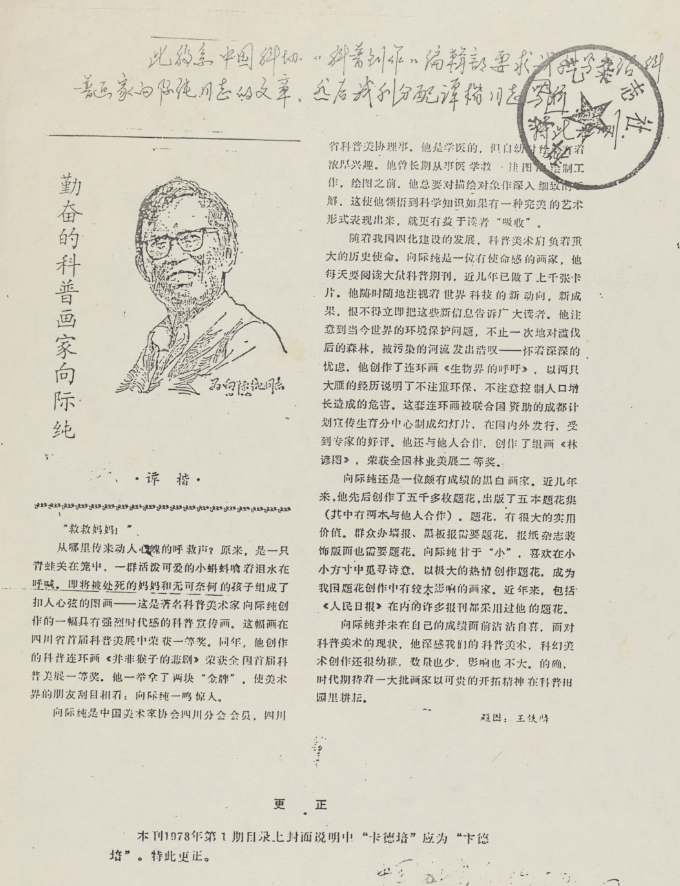
Hardworking Popular Science Illustrator Xiang Jichun
"Help mom!"
Where did the soul-stirring cries come from? It turned out that a little fish trapped in a cage and a group of adorable little tadpoles, shedding tears, were crying out. The mother about to be executed and the helpless child formed a heart-stopping picture - this was a famous popular science artist, Xiang Jichun, who created a highly contemporary popular science propaganda painting with a strong sense of the times. This painting won the first prize in the first popular science art exhibition of Sichuan Province. In the same year, his popular science comic strip "The Tragedy of Not Being a Monkey" won the first prize in the first national popular science art exhibition. He won two "gold medals" at once, which made friends in the art circle look at him with new eyes: Xiang Jichun made a stunning debut.
Xiang Jichun is a member of the Sichuan Branch of the Chinese Artists Association and a director of the Sichuan Science Popularization Artists Association. He studied medicine but has always had a strong interest in painting since childhood. He has been engaged in medical teaching and drawing of diagrams for a long time. Before drawing, he always needs to have a thorough and detailed understanding of the subject he is painting. This has made him realize that if science has a perfect artistic form to express itself, it will be more beneficial for readers to "absorb" it.
With the development of China's four modernization drive, popular science art has taken on a significant historical mission. Liu Jieline is a painter with a sense of mission. Every day, he reads a large number of popular science periodicals. In recent years, he has created over a thousand cards. He constantly keeps an eye on the new trends and achievements in world science and technology, and wishes to immediately convey these new pieces of information to the general public. He has noticed the environmental protection issues in today's world. He has repeatedly lamented the deforested forests and polluted rivers after deforestation - with deep concern, he created the comic strip "The Appeal of the Biological World", using the experiences of two geese to illustrate the harm caused by not paying attention to environmental protection and not controlling population growth. This comic strip was made into slides by the Chengdu Family Planning Publicity Center funded by the United States and was distributed both domestically and internationally, receiving high praise from experts. He also collaborated with others to create the series "Forest Aphorisms", which won the second prize in the National Forestry Art Exhibition.
Xiang Jiuchun was also a highly accomplished black-and-white painter. In recent years, he has created over 5,000 flower-themed paintings and published five collections of such paintings (two of which were co-authored with others). Flower-themed paintings have significant practical value. Public organizations need flower-themed paintings for wall posters and blackboard newspapers, and newspapers and magazines also require flower-themed illustrations. Xiang Jiuchun is content with being "small" and enjoys seeking poetic inspiration within a small space. With great enthusiasm, he creates flower-themed paintings and has become one of the painters with a significant influence in the field of flower-themed painting in our country. In recent years, many newspapers and periodicals, including the People's Daily, have adopted his flower-themed paintings.
Xiang Jichun did not become complacent about his achievements. Facing the current situation of popular science art, he deeply felt that our popular science art and science fiction creation were still very immature. The quantity was small and the influence was insignificant. Indeed, Shi Hua is looking forward to a large number of painters cultivating in the field of popular science with their valuable pioneering spirit.
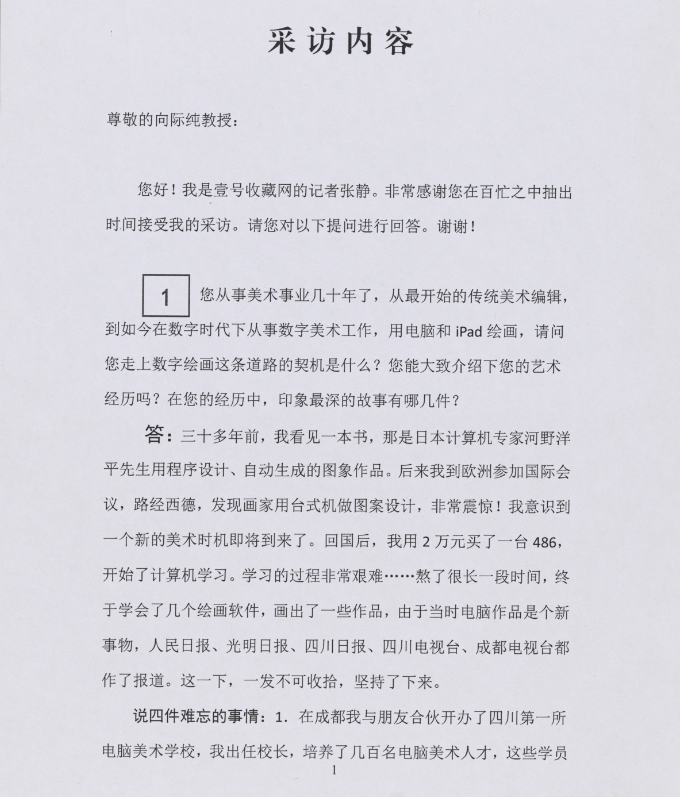
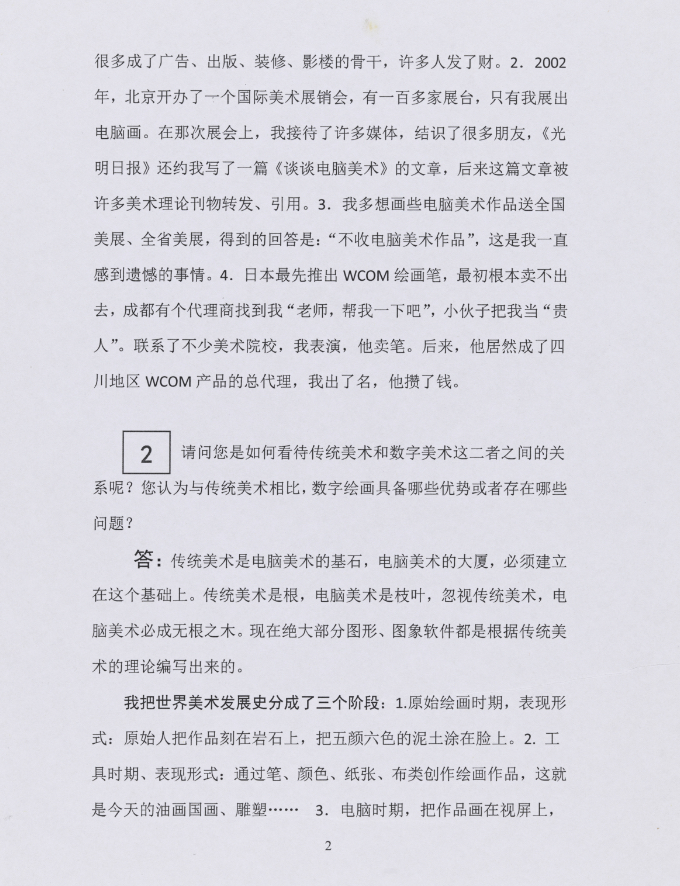
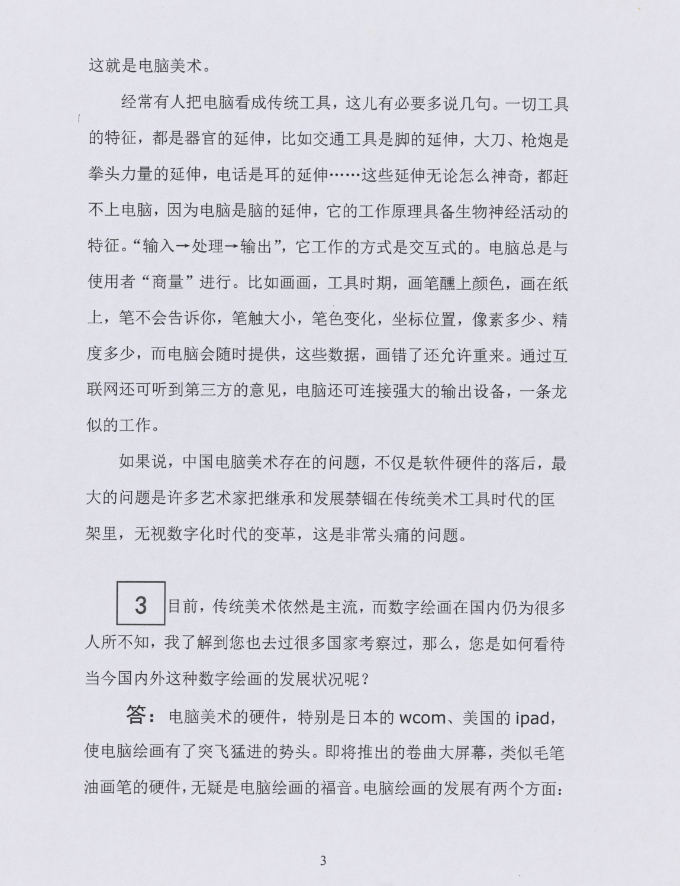
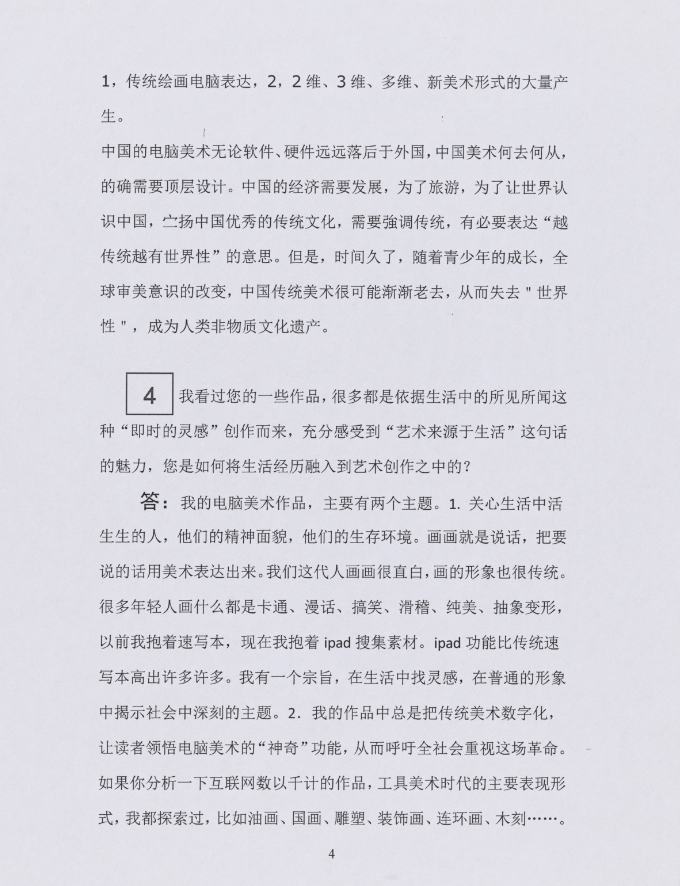
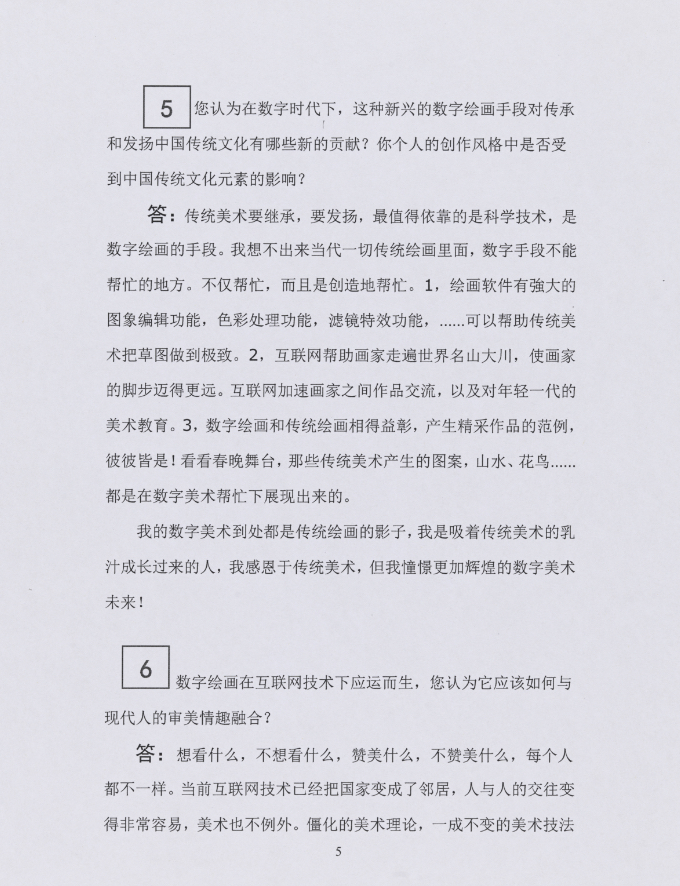
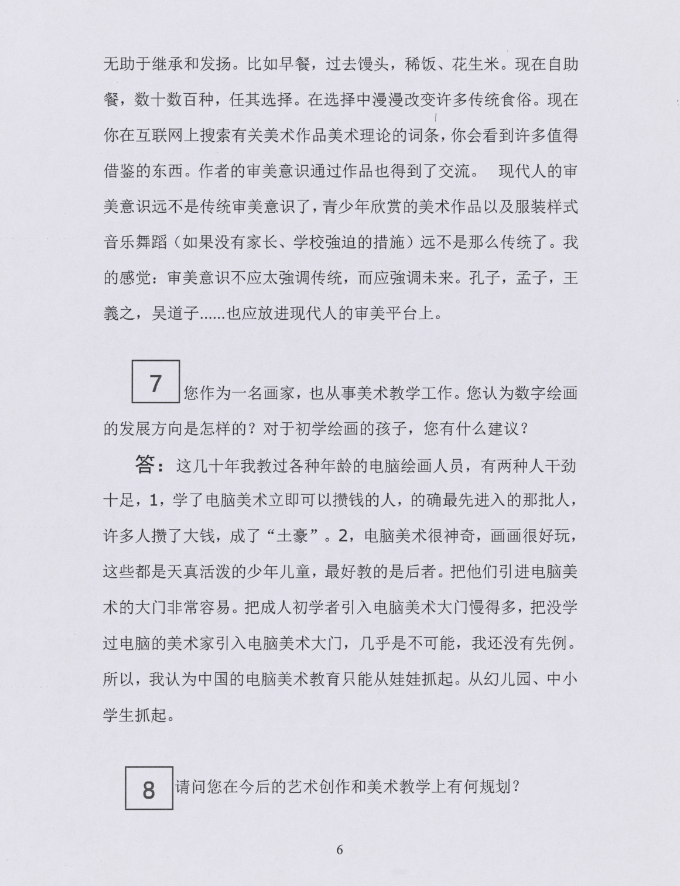
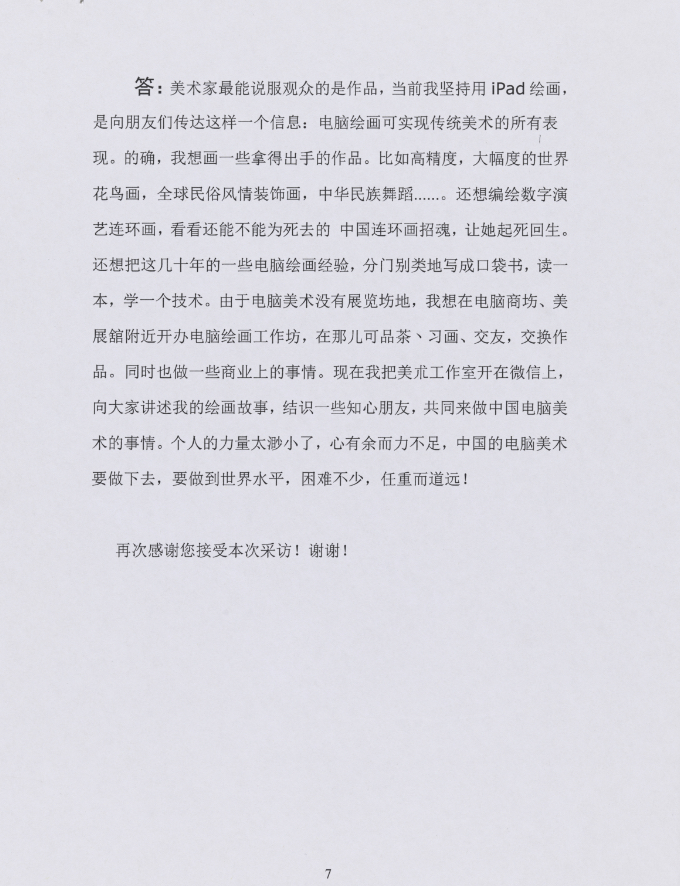
Dear Professor Xiang Jichun: Hello! I'm Zhang Jing, a reporter from One Collection Network. Thank you very much for taking the time out of your busy schedule to meet with me for this interview. Please answer the following questions. Thank you! You have been engaged in the art field for several decades. Starting from the traditional art editing in the beginning,and now working in digital art in the digital age, using computers and iPads for painting. Could you tell me what the trigger was for you to embark on the path of digital painting? Could you briefly introduce your artistic experiences? Which stories were the most memorable in your journey?
Answer:
More than thirty years ago, I saw a book. It was the graphic works created by Japanese computer expert Hiroshi Hayano using programming and automatic generation. Later, I attended an international conference in Europe and passed through West Germany. I was shocked to see painters doing pattern design on desktop computers! I realized that a new era of art was about to arrive. After returning to China, I spent 20,000 yuan to buy a 486 and began computer learning. The learning process was very difficult... I endured for a long time and finally learned several painting software and created some works. Since computer artworks were a new thing at that time, the People's Daily, Guangming Daily, Sichuan Daily, Sichuan Television Station, and Chengdu Television Station all reported it. This led to an unstoppable momentum and I persisted.
I can recall four unforgettable things:
1. In Chengdu, I partnered with a friend to establish the first computer art school in Sichuan. I served as the principal and trained hundreds of computer art talents. Many of these students became key personnel in advertising, publishing, decoration, and photo studios, and many became wealthy.
2. In 2002, Beijing held an international art exhibition and sale, with over a hundred booths. Only I exhibited computer paintings. At that exhibition, I received many media interviews and made many friends. The Guangming Daily also invited me to write an article titled "Talking about Computer Art". Later, this article was forwarded and quoted by many art theory publications.
3. I really wanted to create some computer art works to send to national and provincial art exhibitions. The answer was: "No computer art works will be accepted". This was something I always regretted.
4. Japan was the first to launch the WCOM painting pen. At first, it couldn't sell at all. An agent in Chengdu found me and said, "Teacher, help me out!" The young man regarded me as a "great person". I contacted many art colleges and I performed while he sold the pens. Later, he unexpectedly became the total agent of WCOM products in Sichuan region. I became famous and he saved money.
How do you view the relationship between traditional art and digital art? Do you think that compared to traditional art, digital painting has any advantages or faces any problems?
Answer:
Traditional art is the foundation of computer art. The edifice of computer art must be built on this foundation. Traditional art is the root, and computer art is the branches and leaves. Ignoring traditional art will make computer art like a tree without a root. Now, most graphic and image software is written based on the theories of traditional art.
I divide the history of world art development into three stages:
1. The primitive painting period, the form of expression: primitive people carved their works on rocks and painted colorful mud on their faces.
2. The tool period, the form of expression: creating painting works through pens, colors, paper, and fabrics. This is today's oil painting, traditional Chinese painting, sculpture, etc.
3. The computer period, the works are drawn on the screen, this is computer art.
Many people often regard computers as traditional tools. It is necessary to say a few more words here. The characteristics of all tools are the extension of organs. For example, transportation is the extension of the feet, the big knife, gun, are the extension of the strength to raise the head, the telephone is the extension of the ears... These extensions, no matter how amazing, cannot compare with computers because computers are the extension of the brain. Its working principle has the characteristics of biological neural activities. "Input - processing - output", its working mode is interactive. The computer always "discusses" with the user. For example, in the tool period, the brush applies color and draws on the paper. The brush will not tell you the size of the brush stroke, the change of color, the coordinate position, the number of pixels, the precision, etc., but the computer will provide these data at any time. If you make a mistake, you can still redo it. Through the Internet, you can also hear the opinions of third parties. The computer can also be connected to powerful output devices, like a line work.
If we talk about the problems existing in Chinese computer art,not only the backwardness of software and hardware,the biggest problem is that many artists confine the inheritance and development to the framework of the traditional art tool era,ignoring the changes of the digital era. This is a very troublesome problem.
Recently, traditional art remains the mainstream, while digital painting is still unknown to many people in China. I have learned that you have visited many countries for research. So, how do you view the current development of digital painting both domestically and internationally?
Answer:
The hardware for computer art, especially WCOM from Japan and iPad from the United States, has given a significant boost to computer painting. The upcoming curved large screen, similar to the brush and oil painting brush, is undoubtedly a blessing for computer painting. The development of computer painting has two aspects:
1. Computer expression of traditional painting,
2. The large-scale emergence of 2D, 3D, multi-dimensional, and new art forms.
3.China's computer art, both in software and hardware, lags far behind that of foreign countries. The future direction of Chinese art indeed requires top-level design. China's economy needs to develop. For tourism, to make the world recognize China, and to promote China's excellent traditional culture, emphasizing tradition is necessary. It is important to express the idea that "the more traditional, the more global". However, over time, as teenagers grow up, the change in global aesthetic consciousness, traditional Chinese art is likely to gradually age and lose its "global nature", becoming a non-material cultural heritage of humanity.
4. I have seen some of your works. Many of them are created based on the "immediate inspiration" derived from what one sees and hears in life. I have fully appreciated the charm of the statement "Art originates from life". How do you incorporate your life experiences into your artistic creations?
Answer:
My computer art works mainly have two themes.
1. Pay attention to the living people in life, their mental states, their living environment. Painting is like speaking; expressing what needs to be said through art. Our generation paints very straightforwardly and the images are very traditional. Many young people paint cartoons, comics, funny, comical, pure beauty, abstract and distorted images. Before, I carried a sketchbook, but now I carry an iPad to collect materials. The functions of the iPad are much higher than those of traditional sketchbooks. I have a principle: seek inspiration in life and reveal profound themes in ordinary images of art.
2. My works always digitize traditional art, allowing readers to understand the "magical" functions of computer art and thereby calling on the whole society to pay attention to this revolution.
3. If you analyze the countless works on the Internet, the main forms of expression in the era of tool art, I have explored them all, such as oil paintings, traditional Chinese paintings, sculptures, decorative paintings, comic strips, woodcuts...
In the digital age, what new contributions do you think this emerging digital painting method can make to the inheritance and promotion of Chinese traditional culture? Has your personal artistic style been influenced by elements of Chinese traditional culture?
Answer:
To inherit and promote traditional art, the most reliable thing is science and technology, and digital painting methods. I can't think of any aspect in contemporary traditional painting where digital means cannot help. Not only does it help, but it does so creatively.
1. Painting software has powerful image editing functions, color processing functions, filter effect functions, etc., which can help traditional art to perfect the sketches.
2. The Internet helps painters travel to famous mountains and rivers around the world, enabling their footsteps to go further. The Internet accelerates the exchange of works among painters and the education of young generations in art.
3. Digital painting and traditional painting complement each other, creating exemplary works. There are countless examples! Look at the Spring Festival Gala stage, the patterns, landscapes, flowers and birds produced by traditional art are all presented with the help of digital art.
My digital art is everywhere with the shadow of traditional painting. I grew up absorbing the milk of traditional art. I am grateful to traditional art, but I look forward to a more glorious future of digital art!
Digital painting emerged with the advent of Internet technology. How do you think it should be integrated with modern people's aesthetic tastes?
Answer:
Everyone has different preferences regarding what to look at, what not to look at, what to praise, and what not to praise. The current Internet technology has turned countries into neighbors, making interpersonal communication extremely easy. Art is no exception. Rigid art theories and unchanging art techniques are not conducive to inheritance and promotion. For example, breakfast used to consist of steamed buns, porridge, and peanuts. Now it's a buffet with hundreds or even thousands of options, allowing for free choice. In the process of making choices, many traditional eating customs have undergone significant changes. Now, when you search for terms related to art works and art theories on the Internet, you will find many things worth learning from. The author's aesthetic consciousness is also exchanged through the works. Modern people's aesthetic consciousness is far from the traditional one. The art works, clothing styles, music, and dance that teenagers appreciate, without the intervention of parents or schools, are far from being so traditional. My feeling: Aesthetic consciousness should not overly emphasize tradition but should emphasize the future. Confucius, Mencius, Wang Yizhi, Wu Daozi... should also be placed on the modern people's aesthetic platform.
As a painter, you also engage in art teaching. What do you think is the future direction of digital painting? What suggestions do you have for children who are just starting to learn painting?
Answer:
Over the past few decades, I have taught people of various ages in the field of computer art. There are two types of people who are highly motivated.
1. Those who learn computer art and can start saving money immediately. These are indeed the first batch of people to enter this field. Many of them have saved a lot of money and become "millionaires".
2. Computer art is very magical and painting is very fun. These are innocent and lively children. The latter group is the best to teach. It is very easy to introduce them to the door of computer art. It is much slower to introduce adult beginners to the door of computer art. It is almost impossible to introduce artists who have no experience with computers to the door of computer art. I have no precedent for this yet.
Therefore, I believe that the education of computer art in China should start from children. It should start from kindergartens and primary and secondary schools.
May I ask what your plans are for your future artistic creation and art teaching?
Answer:
What convinces the audience most about an artist's work is the artwork itself. Currently, I continue to use an iPad for painting, which is to convey this message to my friends: Computer painting can achieve all the expressions of traditional art. Indeed, I want to create some outstanding works. For example, high-precision, large-scale world flower and bird paintings, global folk custom decorative paintings, Chinese ethnic dance... I also want to compile digital comic strips and see if I can bring back to life the deceased Chinese comic strips and make them come back to life.
I also want to categorize some of my computer painting experiences and write them into pocket books. After reading one, you can learn one technique. Since there is no exhibition venue for computer art, I want to open a computer painting workshop near the computer store and art exhibition hall, where we can enjoy tea, practice painting, make friends, exchange works. At the same time, I will also do some business things. Now I have my art studio on WeChat, telling everyone my painting stories, making some close friends, and jointly doing things related to Chinese computer art. My personal power is too weak, and I don't have enough strength. China's computer art needs to continue, to reach the world level, there are many difficulties, and the road is long and arduous!
Thank you again for accepting this interview! Thank you!
